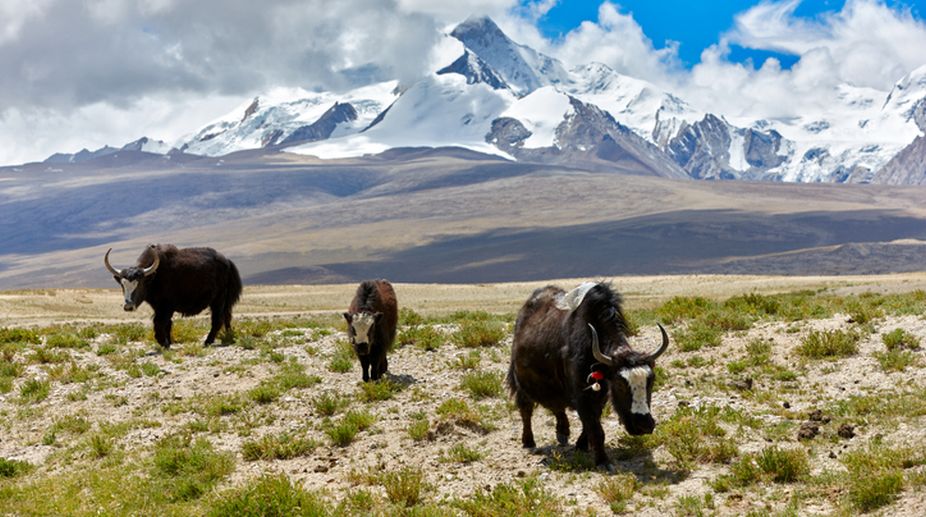The Himalayas (abode of snows) is the mystical dwelling of gods. There is a magnetic pull that draws pilgrims and tourists to this place. Many are the names that lend themselves to this place. Ancient texts, such as the Ramayana, the Puranas, theVedas, the Mahabharata, all sing in unison of the glory and wonder of the Himalayas.
A large number of peaks and ranges in the Great Himalayas are named after Lord Shiva, the Lord of Mountains and his consort goddess Parvati.
Mt. Shivaling, Trishul, Nanda Devi are a few of the very well-known mountains named after Shiva and his family. The most famed and holiest mountain among all these is Mount Kailash (6,714 metres), and on top is the heavenly abode of Lord Shiva, who shares this lofty peak with his consort goddess Parvati.
Holy mountain
The grandeur of Mt Kailash, the famed holy peak in western Tibet situated to the north of the Himalayan barrier. This legendary snow-shrouded rock dome is revered by four different religions as one of the most sacred pilgrimage destination in Asia. Hindus regard Mt. Kailash as the earthly manifestation of Mt Meru, their spiritual centre of universe, described in the ancient texts as a fantastic “World Pillar”, around which everything else revolves, its roots in the lowest hell and its top kissing the heavens. Sprawling below is the sacred lake Manasarovar, where a ritual bath will deliver a pilgrim to Lord Brahma`s paradise and a drink of its holy water relinquishes the sins of a hundred lifetimes.
For the Jains, Mt Kailash is acclaimed as a site where their first prophet achieved enlightenment. Buddhist cosmography identifies Mt Kailash with the mighty Mt Sumeru, the central peak of the world. “The Father Mountain” represents the means to enlightenment, and the lake Manasarovar, “The Mother Principal”, represents Buddhist transcendent consciousness. The holy Mt Kailash, a mystical power in people’s mind has been a symbol of relief from suffering to generation after generation of believers.
Mt Kailash is known in Tibetan as Ghang Rimoche, meaning Precious Jewel of Snow, or by its aboriginal name, Ti-Se. From the slopes of Mt Kailash a stream is said to pour into Lake Manasarovar and from this lake flow four major rivers in four cardinal directions towards the ocean. These mythical rivers are now associated with the four major rivers originating near Mt Kailash ~ the Indus, the Bramhaputra, the Karnali and the Sutlej.
Holy trail
The pilgrimage to Kailash and Manasarovar is considered to be one of the most difficult in Asia. The distances are tremendous, the weather particularly harsh, supplies almost non-existent and bandits are a constant worry. Even with the convenience of roads and four wheel drive vehicles, the route is still an arduous adventure requiring a minimum of 30 days.
Nevertheless pilgrims come from far corners of Asia, defying the hardships to walk the 52 km circuit around Mt Kailash, and 75 km around lake Manasarovar (add approximately 200 km on the Indian side of the yatra). The best time for this pilgrimage is from mid-May to mid-October. The weather is generally stable and visibility best during this time, though temperatures are typically cool during the day and below freezing at night. The present route from New Delhi consists of both bus journey and high altitude mountain trekking.
The trekking route, which takes the pilgrims through some beautiful terrains and passes, covers Tawaghat, Thanidar, Pangu, Sosa, Narayan Ashram, Sirkha, Rungling Top, Simkhola, Gala, Jipti, Gudhi, Guji, Garbhyang, Kalapani, Avidhang, Lipu Lekh pass and Pala Taklakot. The circuit around Mt Kailash and Lake Manasarovar is covered in six days.
The Mt Kailash circuit takes the pilgrims through Tarchen, Direbu, Zongzerebu and back to Tarchen. The circuit around Lake Manasarovar covers Huore, Chugu and Zaidi. This pilgrimage is conducted by Uttar Pradesh State Government and Kumaon Mandal Vikas Nigam (KVMN), in association with Union external affairs ministry. KVMN makes all the arrangements, including accommodation in tin sheds at all the night halts, electricity through generators and simple vegetarian food.
Medical and security facilities are also provided. UP Police, the Prantiya Suraksha Dal and the Indo-Tibetan Border Police provide a compoundable service to the pilgrims. Ponies and porters are also arranged for the convenience of the pilgrims. After Lipu Lekh pass, Chinese authorities take over and provide necessary facilities.
Food is a big problem in Tibet as the Chinese authorities do not make arrangements for food during the parikrama(circumambulance). Hence the Yatris have to carry their own provisions in Tibet.
Kailash parikrama
south-west corner of Ngari, the western province of Tibet. Its dome shaped conical summit rises magnificently above all the neighbouring peaks, the highest point at the west end of the GhagtiseNyanchhan Thangiha range. Across the broad Bharka plains to the south, beyond the waters of Manasarovar and Rakshash Tal, towers another impressive mountain, Gurla Mandhatta (25,255 feet). The inhabitants of this region are the Drogpa, the sturdy Nomadic herders.
The Kora or the Parikarama around Mt Kailash starts and finishes at Tarchen, a small wind-blown settlement at the base of holy Mt Kailash. From Tarchen, the pilgrim circuit enters the Lha Chhu (God’s river) valley, a spectacular canyon below the mountain’s western flanks. As the parikarama swings behind Kailash’s sheer northern face, the trail climbs to the Drolma La, the Dolma Pass (5,670 m), the highest point en route and then descends quickly into the Lham Chhu Khyer valley before turning back towards Tarchen.
Shortly after the Dolma Pass, to the south of the path is a large lake, the Gouri kund (Tukja Tsu, or the Compassion Lake). A dip in the holy water of Gouri Kund vanquishes all languor. It takes half an hour to climb down to it from the path. The scenery around the lake is very dramatic with soaring cliffs rising a 1,000 ft from the turquoise or the frozen waters.
The detour is made to perform ritual ablutions, even though the water is extremely cold. The summit of Mt Kailash is visible from Tarchen though the best views in the area are a climb of about one hour, as one climbs up the ridge directly behind (north of) Tarchen at a height of 16,500 feet. The southern “Sapphire” face of Mt Kailash is stunning from here, its symmetrical slopes and brownish red base halved by a vertical slash known as the Stairway to Heaven.
According to the Hindus, this large cleft in the mountain represents Lord Shiva’s long strands of matted hair falling and flowing about him. The holy river Ganges is said to emanate from one of his strands.
The sheer icy north face of Mt Kailash is unveiled at Direbu. It is a common belief that walking or completing three or 13 circuits is particularly auspicious. Some pilgrims, particularly the Tibetan Bons, complete theparikramadoing full body prostrations along the ground, a slow journey that can take up to two weeks.
One circuit is said to purify all the sins of a life time and 108 circuits will bring enlistment during this lifetime. In Da Lo, the year of the Horse in the 12 year Tibetan calendar, (2014 was the last one), walking the parikramais equal to 13 circuits completed during the year.
To go closer to the base of Mt Kailash, one must have qualified by completing 13 circumambulations by the route.
Manasarovar parikrama
South of Mount Kailash, across the great plain of Bharka at the base of the majestic Mount Gurla Mandhatta, are the two lakes Manasarovar and Rakshash tal. They are the highest bodies of fresh water in the world, with Manasarovar, at 4,558 metres, about 50 metres higher than Rakshash Tal. Manasarovar has been proclaimed as `”The Pearl of the lakes of the world” by noted writer Sven Hedin. The two lakes are connected by a channel called Ganga Chu.
Manasarovar is the larger of the two lakes (1,330 sq km as compared to 224 sq km) and considered by both Hindus and Buddhists to be the more worthy of veneration. Buddhists believe that Queen Maya, Buddha’s mother, was carried here by the gods, and washed prior to giving birth to Buddha. The distance between Manasarovar and Rakshash Tal is just 10 km.
The Lake Manasarovar is situated at a height of 14,950 feet and is about 300 feet deep, whereas, Rakshash Tal is at a height of 14,900 feet and is 150 feet deep. Although Manasarovar is traditionally circumambulated, Rakshash Tal is usually ignored.
Manasarovar’s character or aspect is often clear and bright, whereas Rakshash Tal is frequently moody, overcast and dull. Because of its shape and mood, Manasarovar is likened to the sun and the forces of light, whereas Rakshash Tal is compared to the moon and the forces of darkness.
The circuit around the Manasarovar is longer than that around Kailash but is more or less completely flat. The starting point for theparikramaof Manasarovar is the village of Huore.
The long walk down the eastern shore takes one through diverse and beautiful landscapes, often cutting through areas of desert instead of following the shoreline, finishing at the Chugu or the Trugo monastery on the southern shore of the lake. The next stretch of the parikrama entails a full day’s walk from Chug to Tseti Lake at a place called Zaidi on the western shore. As one turns around the south west corner of the lake, you will notice a cairn made up of several peculiarly shaped rocks, upon which Tibetans make offerings of scarves, sweets and chang (locally brewed liquor).
A couple hours further down the shore one will pass by some tall cliffs, in which are several blackened caves. A climb up provides a magnificent view of the lake. All around the lake, while walking one can peer down into the clear blue water and see giant fish swimming in its depths. One can also watch various kinds of wild geese and ducks.
The Northern shore of the lake is not usually covered as part of the Parikrama because of marshes and cliffs that prevent one from approaching the shoreline. One can only traverse the marshy section in the winter when the ground is frozen.
The Kailash-Manasarovar Yatra is an extremely difficult pilgrimage and the obstacles the people meet in trying to get to here are readily attributed to the power of the mountain itself, which allows only those with sufficient spiritual preparation a glimpse of the magical presence. To describe the trouble of the yatra, Frank Smyth, the great writer has said, “So they venture on their pilgrimage, some born by the ponies, some toiling along in rags, some almost crawling.
What goes on in the minds of these simple folk? Wonderment and fear must be the prime ingredients. Unknown dangers threaten at any moment the gods may let loose their wrath upon the helpless passerby.”
The author is a Delhi based freelance Travel photojournalist











